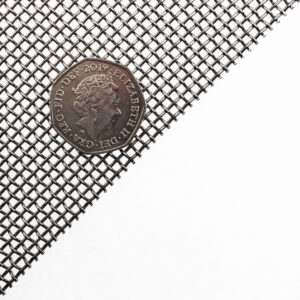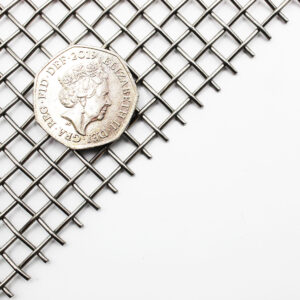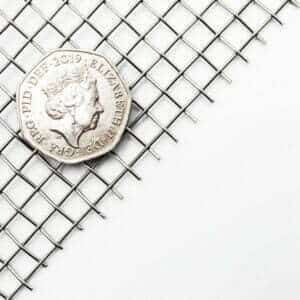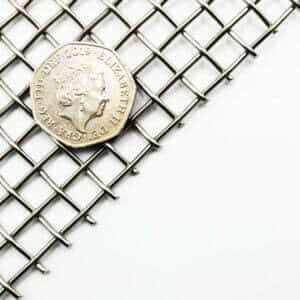







£24.99 – £79.99 inc VAT


This website is secured:
✔ The UK’s Largest Range Of Mesh Products
✔ FREE UK Delivery Included
✔ Immediate Express Dispatch From Stock
✔ Tracked Delivery with Order Updates
✔ 30-Day Returns Accepted
@ ☏ Bespoke Sizes & Larger Sheets Available
Durable and hygienic 2.47mm hole heavy-duty stainless steel varroa mite floor mesh made from 0.71mm wire. With a mesh count of 8 holes per linear inch and 60% open area, this mesh is perfect for beehive floors.
Resistant to weathering, rotting, and mould growth, it’s an excellent investment for beekeepers. Available in sizes for National (450mm x 450mm) and Langstroth (400mm x 500mm) hives.
2.47mm hole heavy-duty stainless steel varroa mite floor made from 0.71mm wire. 2.47mm aperture is fairly large to be woven to form a mesh netting, consequently it requires a thick wire to produce. Most importantly, this mesh is strong and long-lasting.
Stainless steel beehive floors have become increasingly popular among beekeepers due to their durability and hygienic properties. Unlike traditional wooden floors, stainless steel floors are resistant to weathering, rotting, and mould growth. This makes them a great investment for beekeepers who want to make sure their hives remain in the best condition possible.
Below are the specifications of this 2.47mm wire heavy duty mesh:
Filters out particles larger than 2.5mm.
Allows for ideal hive ventilation. The perfect hole size for the dreaded varroa mite.
Varroa mites are an external parasitic mite that attacks honey bees these attacks cause a disease known as Varroatosis. They can only thrive in a honey bee colony and, if unchecked, can spell the end of a hive.
The solution is simple – a woven wire mesh flooring. As the mites fall off their bee hosts they will fall through the mesh. This will prevent them from crawling back up to the bees (as they would be able to with a wooden floor).
Up to 60% of mites could be removed from the hive with this simple approach, moreover using a varroa mesh floor also provides essential ventilation for the colony. In conclusion, varroa mesh floors give air to your hive and make a filter to block varroa mites.
The National and Langstroth are two of the most popular types of beehive designs used in beekeeping.
The National hive is a traditional British design and is typically made of wood. It has a flat roof, a brood box, and one or two supers (boxes where honey is stored). The frames in a National hive are smaller than those in a Langstroth hive, measuring 14″ x 8.5″ and are slightly deeper than Langstroth frames. The National hive is often preferred in the UK due to its suitability for the native honey bee species and its relatively small size, which makes it easier to handle. The mesh panel used for a National hive is 450 x 450mm (17.7″ x 17.7″).
The Langstroth hive, on the other hand, is a popular hive design in the United States and is also commonly made of wood. It has a flat or peaked roof, a brood box, and one or more supers for honey storage. Langstroth hives have frames that are rectangular in shape, typically measuring 19″ x 9.5″, and are shallower than the frames in a National hive. The Langstroth hive allows for more flexibility in hive management and is often preferred by commercial beekeepers. The mesh panel used for a Langstroth hive is 400 x 500mm (15.7″ x 19.7″).
This mesh has 8 holes per linear inch, and a 450mm panel is 17.7″ x 17.7″. So there are approximately 19,881 holes per panel.
Beehive floors are often made of stainless steel because it’s durable, rust-proof, and easy to clean. You should use stainless steel for a beehive floor for these reasons:
It’s strong and durable, so it can handle the weight of the hive and the bees’ activity. Besides being resistant to moisture, heat, and chemicals, the beehive floor can last for a long time.
In environments with high moisture levels, stainless steel is highly resistant to corrosion and rust. The floor of beehives is exposed to honey, wax, and other substances that can cause corrosion.
Cleaning and sanitising stainless steel is easy, which is important if you want a healthy beehive. Cleaning the beehive floor prevents harmful bacteria and fungi from building up.
The stainless steel mesh allows for good ventilation in the hive, which helps regulate the temperature and humidity. Without proper ventilation, the hive can get too hot and humid in warmer climates.
Commonly we offer beehive mesh in stainless steel, black epoxy steel and galvanised.
Technically, we offer the same mesh spec in brass and copper, but neither have ever been used for beekeeping applications before.
We recently published a detailed guide on the benefits of using wire mesh for a floor in your beehive. This article will tell you everything that you need to know to be able to us wire mesh as the bottom layer of your beehive.
Contact our team today if you have any questions at all. We are always really keen to help in any way that we can.
We also offer similar products through our highly popular eBay store, check us out there too.
| Beekeeping Mesh | 450mm x 450mm x 2, 450mm x 450mm x 4, 450mm x 450mm x 8, 450mm x 450mm x 16, 400mm x 500mm x 2, 400mm x 500mm x 4, 400mm x 500mm x 8, 400mm x 500mm x 16 |
|---|
In 2008 Locker Wire Weavers launched The Mesh Company to bring our enormous range of wire mesh products to the general public for the first time. Previously wire mesh was only available for trade customers.
We continue to extend our range, and now proudly offer many forms of mesh and metal products for the best possible prices. We specialise in woven wire mesh. As a group we work closely with architects and designers to develop ground-breaking new applications for our multifunctional range of materials. We also offer state of the art fabrication and engineering for projects of all sizes.
Strong ties with the Warrington community continue to be at the very core of our business. We are proud to invest in the training and developing our staff of all levels in line with the traditions set by Thomas Locker, who founded our group 150 years ago when he invented the electronic loom. We continue to bring ingenuity and strong ethics to our day to day business.
The Mesh Company continues Warrington’s historic role in the wire industry. For more than 140 years, our group has been a leader in the supply and manufacture of woven wire mesh and wire cloth. Having been founded in Warrington, UK in 1878, Locker mesh products still retain the quality craftsmanship and spirit of innovation that were so characteristic then.
Available Options
You will find full rolls of this insect netting here. Please be advised that the majority of woven mesh is usually available in a maximum roll size of 30 metres by 1200mm. Please email us if you wish to discuss purchasing this mesh in any size – sales@themeshcompany.com.
Feel free to call us if you wish to discuss any of our products – (+ 44) 01925 406 602. We are always happy to help in any way that we are able to.
We also offer this product through our highly popular eBay store, check us out there too.




The largest range of wire mesh, chicken wire, wire fencing, woven wire mesh and perforated metal products in Europe, delivered direct from our Warrington warehouse.




Website by: Beech Web Services | Terms and Conditions | Cookie Policy | Privacy Policy | Website Terms and Conditions
Reviews
There are no reviews yet.